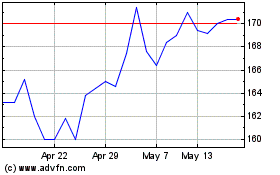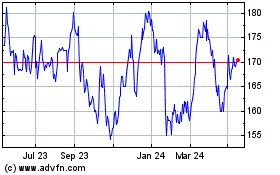The Board is recommending a final dividend of 2.65 pence per
share (2010 - 2.12 pence), bringing the total dividend for the year
to 3.80 pence (2010 - 3.12 pence), a 22% increase over 2010. At the
level recommended, the full-year dividend would be covered 3.8
times (2010 - 3.8 times) by adjusted underlying earnings per share.
The final dividend, if approved, will be paid on 31 May 2012 to
shareholders on the register at close of business on 4 May
2012.
Markets and Operations
Aerospace Division
The Aerospace Division benefited from the continued
implementation of the Group's strategy to increase its market share
on major large commercial aircraft platforms. Improved volumes
across all sectors, particularly in the large commercial aircraft
and military and defence markets, and GBP15.6m of revenue from the
acquired businesses, resulted in reported sales for the Aerospace
Division increasing by 15% to GBP382.6m (2010 - GBP333.8m). The
reported operating margin for the Division increased to 15.6% (2010
- 15.0%), as increased volumes were delivered from existing cost
bases and efficiencies improved. As a result, the Aerospace
Division's reported adjusted operating profit increased by 19% to
GBP59.6m (2010 - GBP50.0m).
Overall, the market for commercial aircraft (57% of 2011
divisional sales) improved during 2011, from an already healthy
level, with production of large commercial aircraft (42% of
divisional sales) leading the way and the Division's sales to this
market increasing by 23% over the prior year. Increased build
rates, higher market share and the acquisitions of Damar and Weston
were the main reasons for the increase. As expected, the end market
for business jets (10% of divisional sales) remained weak.
Deliveries of regional jets (5% of divisional sales) were slightly
improved.
Boeing and Airbus collectively delivered 1,011 commercial
aircraft in 2011, 4% up on the prior year level of 972 aircraft.
More importantly, they reported a combined net order intake of
2,224 aircraft, more than twice the rate of deliveries, such that
their combined order book increased to 8,208 aircraft at the end of
2011 (31 December 2010 - 6,995), an extremely healthy eight-year
order book at current build rates. As a consequence, Boeing and
Airbus are in the early stages of increasing the build rates of
almost all of their aircraft programmes over the coming years
which, given large commercial aircraft represents Senior's largest
market sector, provides very encouraging prospects for the Group.
Also important to Senior was the entry into service in the final
quarter of 2011 of Boeing's 787 and 747-8 aircraft, with production
of the 787, on which Senior has significant shipset value, now
anticipated to increase steadily to a production rate of 120
aircraft per annum by 2014.
Having reached a peak during 2008, when 1,315 aircraft were
delivered, the business jet market has been in steady, albeit
slowing, decline falling to 870 aircraft deliveries in 2009 and 763
in 2010. Although 2011 saw a further 6% decline, Senior increased
its revenue from the business jet market by 11% as production of
certain newer and larger aircraft on which Senior has healthy
content, such as Gulfstream's G650 and Bombardier's GL5000,
increased. As anticipated, the regional jet market was subdued
although Bombardier and Embraer, currently the two largest regional
jet manufacturers, did report a combined increase in deliveries to
206 aircraft (2010 - 183). Unfortunately, their combined order
intake was lower than deliveries and, in Bombardier's case its
order book is at a level which is expected to result in a reduction
in production during 2012. More positively, China, Japan and Russia
are in the advanced stages of developing their own regional jets
and Senior has good content on each. The first of these, the
Russian Superjet 100, entered service in 2011 with five aircraft
being delivered in the year.
Despite the ongoing defence budgetary cuts in North America and
Europe, the Aerospace Division's sales to the military and defence
market (29% of divisional sales) increased by 10% in 2011 over the
prior year. Senior's principal military programmes are the Sikorsky
Black Hawk helicopter and the Lockheed Martin C-130J military
air-transporter, where build-rates increased. In addition to the
apparent solid prospects for these two programmes, the entry into
service during the coming years of the Airbus A400M military
air-transport aircraft and Lockheed Martin's F35 Joint Strike
Fighter, where increasing development revenue was reported in 2011,
can be anticipated to provide sales growth for Senior in this
generally uncertain marketplace.
Flexonics Division
With the exception of the passenger vehicle sector, the
Flexonics Division saw increased volumes across all of its
principal markets, with the heavy truck and off-highway vehicle
sector seeing the strongest growth. Total revenue for the Division
increased by 11% to GBP258.5m (2010 - GBP233.5m). In a similar
fashion to the Aerospace Division, the operating margin of the
Flexonics Division improved, to 13.9% (2010 - 13.5%), due to the
increased volumes being delivered from existing cost bases and
manufacturing efficiency improvements. These revenue and margin
increases resulted in reported adjusted operating profit for the
Division increasing by 14% to GBP36.0m (2010 - GBP31.6m).
Sales to land vehicle markets (passenger vehicles, commercial
trucks and off-highway vehicles) accounted for 52% of the Flexonics
Division's sales in 2011. In line with the Group's strategy, the
proportion of divisional sales to heavy-duty vehicle markets
increased to 22% in 2011 (2010 - 19%), whilst those to the
passenger vehicle markets declined to 30% (2010 - 34%). Sales to
industrial markets, such as petrochemical, power generation,
medical and heating & ventilation, accounted for the remaining
48% of divisional sales in 2011.
European passenger vehicles and North American heavy-duty diesel
vehicles are currently the most important land vehicle markets for
the Group, accounting for around 75% of land vehicle sales in 2011.
Over half of the remainder was derived from the European truck
market (mainly Germany) and the Brazilian passenger car sector.
Senior also has a meaningful and growing presence in the Indian
passenger vehicle market. 2011 saw mixed fortunes for the Group's
largest markets with the number of medium- and heavy-duty trucks
sold in North America increasing by 37% to 375,000 vehicles whilst
the number of passenger vehicles registered in the 27 European
Union countries declined by 2% to 13.1 million vehicles. In Europe,
sales of medium- and heavy-duty trucks increased by 25% but, in
Brazil, passenger vehicle sales ended slightly below the volumes
seen in 2010 as the market gradually weakened after a strong start.
In total, the Group's land vehicle sales were 8% higher in 2011
than during the prior year.
Activity in the Group's industrial markets was generally healthy
throughout 2011, with volumes in the German general industrial, UK
nuclear, North American fuel cell and Canadian oil sands markets
seeing the strongest improvements. Overall, the Group's industrial
revenue was 14% higher than in 2010, partially due to the full-year
effect of the WahlcoMetroflex acquisition made in August 2010.
However, sales of large metallic and fabric expansion joints, the
Group's primary industrial product, saw some weakness in North
America during 2011, principally due to a delay in the
implementation of anticipated environmental legislation.
Pleasingly, order intake improved markedly towards the year-end,
largely due to bookings from Asia and the positive impact of
increased collaboration across the Division, and the order book for
large industrial expansion joints is at an encouraging level going
into 2012.
Employees and the Board
As previously announced, I intend to retire from the Board at
the close of the Group's Annual General Meeting on 27 April this
year after 11 years on the Board, the last five as its Chairman.
Senior has made considerable progress during this period and the
Group is well positioned to continue to do so for the foreseeable
future. These achievements are largely down to the hard work and
dedication of the Group's management and employees and I would
personally like to thank everybody involved for contributing to
Senior's success during this time.
As a result of the healthy organic growth, and the acquisitions
of Damar and Weston, the Group's headcount increased to 5,878 by
the end of the year (31 December 2010 - 4,949). Two-thirds of the
increase in headcount was due to the two acquisitions, to whose
employees I would like to extend an especially warm welcome to the
Group.
During the second quarter of 2011, and following the departure
of Michael Steel as a non-executive Director, the opportunity was
taken to enlarge and strengthen the Board through the recruitment
of two additional non-executive Directors. Accordingly, Andy
Hamment (Group Marketing Director of Ultra Electronics Holdings
plc) and Mark E. Vernon (Group Chief Executive Officer of
Spirax-Sarco Engineering plc) joined the Board on 29 April. Mark
and Andy each have extensive experience of managing successful
international specialist engineering companies, operating in
similar environments to Senior, which is already proving to be of
significant value to the Group.
On 26 January this year, the Board announced the forthcoming
appointment of Charles Berry as Chairman of the Group upon my
retirement. Charles brings a broad experience of listed companies
and industrial markets, most recently as Chairman of Drax Group
plc, and has the right skills and personality to lead the Group
through the next phase of its successful growth development. He
will join the Board as a non-executive Director on 1 March 2012,
with the intention of taking over from me as its Chairman at the
conclusion of the Group's Annual General Meeting. I wish him every
success for the future.
Outlook
Senior (LSE:SNR)
Historical Stock Chart
From Jun 2024 to Jul 2024

Senior (LSE:SNR)
Historical Stock Chart
From Jul 2023 to Jul 2024
